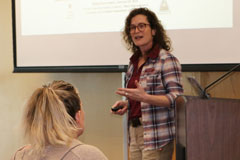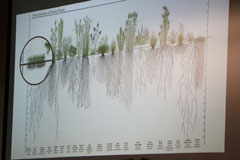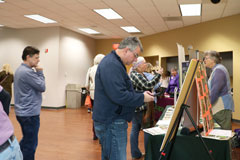Spring is near and this was very apparent by the crowd of over 100 who turned out on a sunny – but cool Sunday afternoon in February to learn about native plants at the Ballwin Grows Native 2025 event!
Three Wild Ones St. Louis members: Krystal Coxon, Eileen Graessle and Lori Stringer proposed this educational event to Ballwin Parks and Recreation to educate Ballwin and surrounding communities on the benefits of native plants. There were presentations, vendor exhibits and native plant experts available to discuss specific circumstances and make recommendations.
Marsha Gebhardt, St. Louis Chapter President, introduced the presenters. Adam Peper, Ballwin Recreation Manager for the City of Ballwin, collaborated with our Wild Ones members to host the native gardening event. Adam spoke on the initiative and introduced Ballwin staff to contact with questions.
Erin Goss of Shaw Nature Reserve discussed Introducing Native Plants into Existing Gardens, covering a wide variety of topics and suggestions. She began by recommending a visit to Shaw Nature Reserve’s Whitmire Wildflower Garden and demonstration gardens for inspiration.
“Leave the leaves” to accommodate overwintering insects introduced an important native gardening concept as she emphasized the importance of insects to the wildlife food chain. She discussed ways to select the correct plant for your garden based on a variety of factors and how you can substitute natives for well-known non-natives to benefit wildlife. She closed by identifying a variety of resources such as Grow Native’s extensive plant database and lists for various goals such as attracting butterflies or specific growing conditions such as sun or rain garden. MDC provides grants and St. Louis Community College offers classes.
Taylor Heuermann of the Missouri Botanical Garden Sustainability Division presented Slow Down and Soak Up! Native plant gardening to manage stormwater.
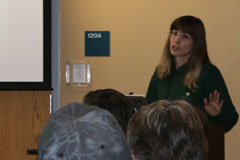 Managing runoff is critical to maintaining the quality of our water and to avoiding property damage. this is a challenge met by native plants through rainscaping.
Managing runoff is critical to maintaining the quality of our water and to avoiding property damage. this is a challenge met by native plants through rainscaping.
Rainscaping manages the water as close as possible to where it falls, helping prevent flooding, erosion and sewage overflows into waterways.  Here the deep roots of native plants and trees are shown, illustrating how the effective use of native plants can soak up the rainwater. The left-most area shows the shallow Bermuda grass roots. Otherwise, rainwater travels along impervious services such as parking lots and roadways and even lawns.
Here the deep roots of native plants and trees are shown, illustrating how the effective use of native plants can soak up the rainwater. The left-most area shows the shallow Bermuda grass roots. Otherwise, rainwater travels along impervious services such as parking lots and roadways and even lawns.
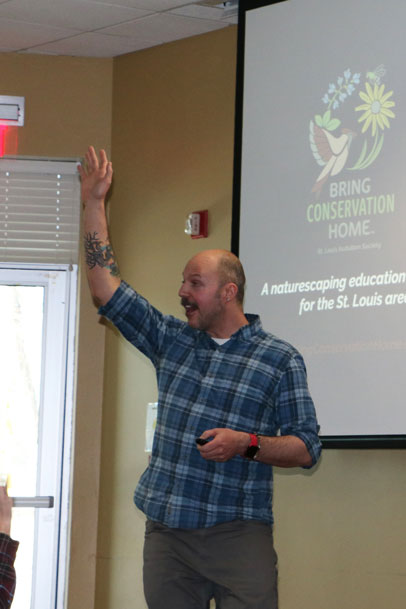 Landscaping for Wildlife was presented by Dan Pearson from the St Louis Audubon Society’s Bring Conservation Home Program. Dan began his presentation with the challenge of habitat loss and how we can meet this challenge by doing “less”:
Landscaping for Wildlife was presented by Dan Pearson from the St Louis Audubon Society’s Bring Conservation Home Program. Dan began his presentation with the challenge of habitat loss and how we can meet this challenge by doing “less”:
- Mows Less
- Water less
- Fertilize less
- Mulch less
- Rake Less
- Cleanup Less
Information tables and resources about native plant topics were available before and after the presentations. They included combatting “deer pressure” and native plant guides and reference books available from the St. Louis County Library.
The interest level of the attendees was obvious. Very few people left their seat during the presentations and many stayed after the program for discussion with the experts on hand. Many commented on how valuable they thought the event was!

